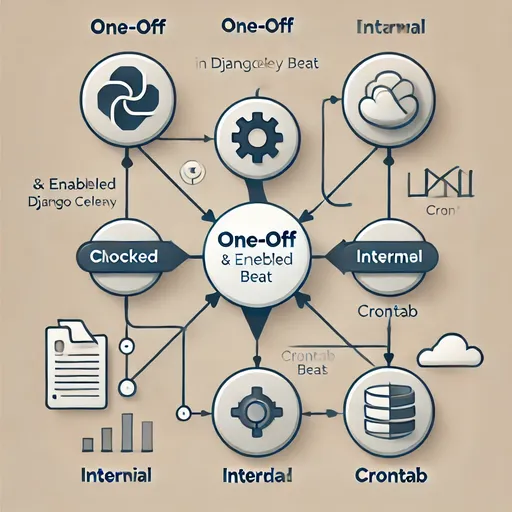When scheduling tasks using Django Celery Beat, you might consider using one-off: True to ensure that a task is executed exactly once. However, many questions arise regarding the status post-execution, particularly concerning the management of the enabled field. In this post, we will explore how one-off functions, the role of the enabled field, and how to use these effectively.
1. The Role of one-off in Celery Beat
The one-off option in Celery Beat is used to ensure that a scheduled task runs only once. A task set with one-off: True will not run again after execution, and Celery Beat will exclude this task from the execution list.
The Relationship Between one-off and Scheduling Methods
clockedschedule:This method executes a task at a specific time. Once the execution time passes, the task will not run again, making it behave similarly to
one-off.When additionally setting
one-off: True: It guarantees that even after the execution time has passed, the task will not be reactivated.intervalandcrontabschedules:These are designed for periodic task execution.
When setting
one-off: True: The task will run only once, regardless of the interval.
2. Changes to the enabled Status After Execution
The Default Behavior of the enabled Field
Even after a task has been executed, the enabled value does not change automatically. In other words, even when a task set with one-off: True is executed, enabled remains True. This means:
- Celery Beat considers only those tasks with
enabledasTruefor scheduling. - If
one-offis set, that task is excluded from scheduling after execution.
Therefore, there is no need to explicitly change the enabled field to prevent the task from running again.

3. Should enabled Be Changed to False?
Reasons Not to Change
- Celery Beat handles task re-execution purely based on the
one-off: Truesetting. - If developers clearly understand and manage task states, it is safe not to change
enabled.
Instances Where Changing Might Be Beneficial
- Enhancing Safety:
Prevents the possibility of someone accidentally removing or modifying the
one-offsetting. - Clarifying Intent:
Explicitly indicates that the task has been completed, aiding subsequent managers in understanding the task’s status.
- Optimizing Resource Management:
If many tasks are
enabled: True, this can help reduce the database load for Celery Beat.
How to Change enabled
After a task is executed, you can modify the enabled value to False through additional logic. For example:
from django_celery_beat.models import PeriodicTask
def my_task():
# Execute task contents
...
# Change enabled value to False after execution
task_name = "my_task_name"
task = PeriodicTask.objects.get(name=task_name)
task.enabled = False
task.save()4. Is a clocked Schedule Alone Sufficient?
clocked schedule is designed to run a task once at a specific time. Therefore, once the execution time elapses, the task will not run again even without one-off: True.
- If only
clockedis used:The task is automatically disabled after the execution time.
However, additional settings may be needed to prevent the task from failing or being manually reactivated.
clocked+one-off: True:This ensures that a task does not get reactivated and clearly expresses intent.
5. Conclusion: A Practical Setup Guide
- If a task should run only once: Ensure safety by setting
one-off: True. - There is usually no need to change
enabled. However, you may change it toFalseas needed for safety and maintainability. - If using only
clockedis sufficient: It is acceptable not to setone-off.
By effectively utilizing the configuration options of Celery Beat, task management can become much more efficient and secure. Find the optimal settings that suit your project requirements!

There are no comments.